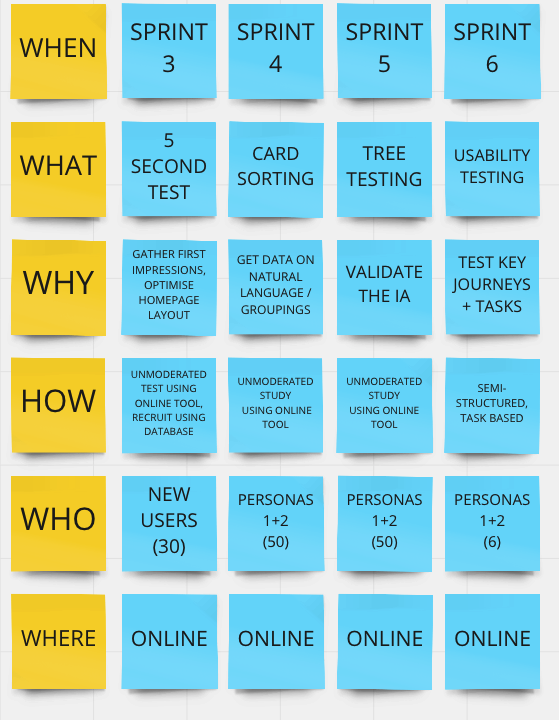User research planning template
Whether you’re a team of one, or you’re doing user research for a large organisation, planning is a fundamental part of the user research process.
Communication is the key to any successful UX research strategy and this technique is a really simple and effective way of communicating and planning your user research activities with your team and stakeholders.
Why you should use this:
It’s faster than writing a document
It will increase team engagement
Anyone can use it with no training needed
It’s quick and customisable to your needs
You can use any tool you like to make it, including a spreadsheet, a document, or keep it lo-fi with sticky notes or Miro as I did
This technique uses the 5 Whys and 1 How framework. Here’s a quick overview of each heading and how I use it.
When
Shows when the research is taking place, using either the date, week or sprint (use whichever reference point works for you and your team).
What
Use this row to quickly show people what you’re planning to do. I show the research method in my example, but you might want to simplify the language (e.g. ‘Test feature X’) depending on who your audience is.
Why
Show why you are doing this piece of research - what is the goal and what do you want to learn?
How
Use this row to tell people how you plan to run the research and add in any extra details. For example, is it going to be done face-to-face or remote?
Who
Or ‘who with’ to show who you are going to include in this piece of research (e.g. participants, stakeholders, team members).
Where
The location where the research is taking place. In the example below, the research is all online but you may be doing research across different geographical areas or a mix of in-person and online research, so use accordingly.
Example of a user research plan using the 5 Whys and 1 How framework.
The good thing about using this technique is that you can add, change and move headings however you like. For example, I use the date (or ‘When’) in the first row, followed by the method (‘What’) so it’s easier to see what’s happening, but you might want to focus the plan on your research question or goal and start with ‘Why’ you’re doing the research in the first place. You can also play about with the names of the headings as you see fit. For example, ‘How’ might be ‘How many’ to show how many people you’re including in that particular round of research.
Hope you find this useful. If you have any questions or comments, please get in touch at hello@userlab.co.uk

